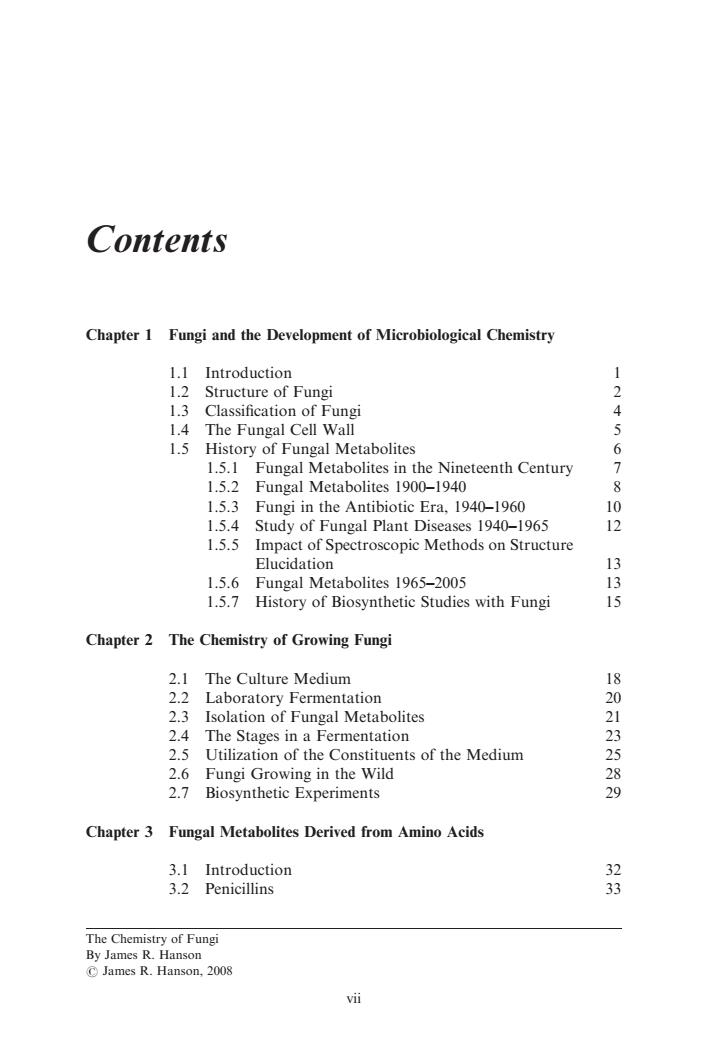
Contents Chapter 1 Fungi and the Development of Microbiological Chemistry 1.5 History of Fungal Metabolites 6 1.5.1 Fungal Metabolites in the Nineteenth Century 1.5. Fungal Metabolites 1900-1940 153 15.5 796 1.5.6 Fungal Metabolites 1965-2005 1.5.7 History of Biosynthetic Studies with Fungi 15 Chapter 2 The Chemistry of Growing Fungi The Culture Medium 3 ngal Met bolite 4 The Stages in a Fermentation 23 2.5 Utilization of the Constituents of the Medium 2.6 Fungi Growing in the Wild 2.7 Biosynthetic Experiments Chapter 3 Fungal Metabolites Derived from Amino Acids 3.1 Introduction 3.2 Penicillins
Contents Chapter 1 Fungi and the Development of Microbiological Chemistry 1.1 Introduction 1 1.2 Structure of Fungi 2 1.3 Classification of Fungi 4 1.4 The Fungal Cell Wall 5 1.5 History of Fungal Metabolites 6 1.5.1 Fungal Metabolites in the Nineteenth Century 7 1.5.2 Fungal Metabolites 1900–1940 8 1.5.3 Fungi in the Antibiotic Era, 1940–1960 10 1.5.4 Study of Fungal Plant Diseases 1940–1965 12 1.5.5 Impact of Spectroscopic Methods on Structure Elucidation 13 1.5.6 Fungal Metabolites 1965–2005 13 1.5.7 History of Biosynthetic Studies with Fungi 15 Chapter 2 The Chemistry of Growing Fungi 2.1 The Culture Medium 18 2.2 Laboratory Fermentation 20 2.3 Isolation of Fungal Metabolites 21 2.4 The Stages in a Fermentation 23 2.5 Utilization of the Constituents of the Medium 25 2.6 Fungi Growing in the Wild 28 2.7 Biosynthetic Experiments 29 Chapter 3 Fungal Metabolites Derived from Amino Acids 3.1 Introduction 32 3.2 Penicillins 33 The Chemistry of Fungi By James R. Hanson r James R. Hanson, 2008 vii

Contents 3.3 Cephalosporins 3 4 Biosynthesis of B-Lactams 3.5 Metabolites Containing a Diketopiperazine Ring 39 % 3.5.2 Gliotoxi 3.6 The Cyclopenin-Viridicatin Group of Metabolites 3.7 Tryptophan-derived Metabolites 3.8 Glutamic Acid Derivatives 3.9 Fungal Peptides 45 Chapter 4 Polyketides from Fungi 4.1 Introduction 47 4.2 Polvketide Biosynthesis 48 4.3 Triketides 4.4 Tetraketides 51 4.4.1 6-Methylsalicylic Acid 4.4.2 Patulin and Penicillic Acid 443 Gladiolic Acid and its Relatives 4.4.4 Tetrake tide T nes 4.4.5 Mycophenolic Acid 567 4.5 Pentaketides 4.5.1 Citrinin 4.5.2 Terrein 4.6 Hepta-and Octaketides 4.6.1 Griseofulvin 61 4.6.2 Cladosporin(Asperentin) 47 Polyketide Lactones Statin Cytochalas ins 568 4.10 Fatty Acids from Fung 8 4.11 Polyacetylenes from the Higher Fungi 70 Chapter 5 Terpenoid Fungal Metabolites 5.1 Introduction D 3 osynthesis of Fungal Terpenoids Mo 54 Sesquiterpenoids 5.4.1 Cyclonerodiol 5.4.2 Helicobasidin 5.4.3 Trichothecenes 5.4.4 PR-Toxin 5.4.5Botryanes 81
3.3 Cephalosporins 36 3.4 Biosynthesis of b-Lactams 37 3.5 Metabolites Containing a Diketopiperazine Ring 39 3.5.1 Mycelianamide 40 3.5.2 Gliotoxin 40 3.6 The Cyclopenin-Viridicatin Group of Metabolites 42 3.7 Tryptophan-derived Metabolites 42 3.8 Glutamic Acid Derivatives 44 3.9 Fungal Peptides 45 Chapter 4 Polyketides from Fungi 4.1 Introduction 47 4.2 Polyketide Biosynthesis 48 4.3 Triketides 50 4.4 Tetraketides 51 4.4.1 6-Methylsalicylic Acid 51 4.4.2 Patulin and Penicillic Acid 52 4.4.3 Gladiolic Acid and its Relatives 55 4.4.4 Tetraketide Tropolones 56 4.4.5 Mycophenolic Acid 57 4.5 Pentaketides 58 4.5.1 Citrinin 58 4.5.2 Terrein 60 4.6 Hepta- and Octaketides 61 4.6.1 Griseofulvin 61 4.6.2 Cladosporin (Asperentin) 64 4.7 Polyketide Lactones 65 4.8 Statins 66 4.9 Cytochalasins 68 4.10 Fatty Acids from Fungi 68 4.11 Polyacetylenes from the Higher Fungi 70 Chapter 5 Terpenoid Fungal Metabolites 5.1 Introduction 73 5.2 Biosynthesis of Fungal Terpenoids 73 5.3 Monoterpenoids 76 5.4 Sesquiterpenoids 76 5.4.1 Cyclonerodiol 77 5.4.2 Helicobasidin 78 5.4.3 Trichothecenes 78 5.4.4 PR-Toxin 81 5.4.5 Botryanes 81 viii Contents

Contents ix 5.4.6 Culmorin and Helminthosporal 5.4.7 Sesquiterpenoids of the Basidiomycetes 43 5.5 Diterpenoid fungal metabolites 93 5.51 Virescenosides 552 Rosanes 2 55.3 Gibberellins and Kaurenolides 554 55.5 Aphidicol 5.5.6 Fusico cins and Cotylenins Sesterterpenoids 5.7 Fungal Triterpenoids and Steroids 185 5.7.I Ergosterol 106 57.2 Fusidane Steroidal Antibiotics 107 5.7.3 Viridin,Wortmannin and their Relatives 111 5.7.4 Triterpe 113 5.8 Meroterpenoid 116 Chapter 6 Fungal Metabolites Derived from the Citric Acid Cycle 6.1 Introduction 120 6.2 Citric Acid and Related Acids 120 6.3 Fungal Tetronic Acids Canadensolide and Avenaciolide 65 Nonadrides 124 6.6 Squalestatin 126 Chapter 7 Pigments and Odours of Fungi 7.1 Introduction 127 7.2 Polyketide Fungal Pigments 128 7.2.1 Fumigatin 128 7)) Auroglaucin and Flavoglaucin 129 73 Hyd oxyanth he Pigme 74 apht opyrone Pigments 7.2.5 Extended and Dimeric Quinone 131 7.3 Fungal Pigments Derived from the Shikimate Pathway 1 7.3.1 Terphenyls 32 7.3.2 Pulvinic Acids 13 7.4 Some Pigments Containing Nitrogen 135 7.5 138 al Carotenoids 138 7.6 Lichen Subs 7.7 Od ours of Fungi 7.7.1 Organoleptic Components of Mushrooms 7.7.2 Volatile Fungal Metabolites Containing Sulfur
5.4.6 Culmorin and Helminthosporal 84 5.4.7 Sesquiterpenoids of the Basidiomycetes 85 5.5 Diterpenoid Fungal Metabolites 93 5.5.1 Virescenosides 94 5.5.2 Rosanes 94 5.5.3 Gibberellins and Kaurenolides 97 5.5.4 Aphidicolin 101 5.5.5 Pleuromutilin 102 5.5.6 Fusicoccins and Cotylenins 102 5.6 Sesterterpenoids 104 5.7 Fungal Triterpenoids and Steroids 105 5.7.1 Ergosterol 106 5.7.2 Fusidane Steroidal Antibiotics 107 5.7.3 Viridin, Wortmannin and their Relatives 111 5.7.4 Triterpenoids of the Basidiomycetes 113 5.8 Meroterpenoids 116 Chapter 6 Fungal Metabolites Derived from the Citric Acid Cycle 6.1 Introduction 120 6.2 Citric Acid and Related Acids 120 6.3 Fungal Tetronic Acids 122 6.4 Canadensolide and Avenaciolide 123 6.5 Nonadrides 124 6.6 Squalestatins 126 Chapter 7 Pigments and Odours of Fungi 7.1 Introduction 127 7.2 Polyketide Fungal Pigments 128 7.2.1 Fumigatin 128 7.2.2 Auroglaucin and Flavoglaucin 129 7.2.3 Hydroxyanthraquinone Pigments 129 7.2.4 Xanthone and Naphthopyrone Pigments 130 7.2.5 Extended and Dimeric Quinones 131 7.3 Fungal Pigments Derived from the Shikimate Pathway 132 7.3.1 Terphenyls 132 7.3.2 Pulvinic Acids 133 7.4 Some Pigments Containing Nitrogen 135 7.5 Terpenoid Pigments 138 7.5.1 Fungal Carotenoids 138 7.6 Lichen Substances 140 7.7 Odours of Fungi 142 7.7.1 Organoleptic Components of Mushrooms 142 7.7.2 Volatile Fungal Metabolites Containing Sulfur 144 Contents ix

Contents Chapter 8 The Chemistry of Some Fungal Diseases of Plants 8.1 Introduction 147 8.2 General Chemistry of Plant-Fungal Interactions 14 8.3 Chemistry of some Leaf-spot Diseases 8.3.1 Botrytis cinerea 14g 8.3.2 Alternaria Leaf-spot Diseases 151 8.3.3 Cercospora Leaf-spot Diseases 153 83.4 Diseases Caused by 8.4 ease of the Gramineae fecting Fungi 8.6 Some Fungal Diseases of Trees 4151599 8.6.1 Dutch Elm Disease 8.6.2 Eutypa Dieback 160 8.6.3 Armillaria mellea 161 8.6.4 Phytophthora cinnamomi 162 8.6.5 Silver-leaf Disease 866 ria lligena Canker 8.6.7 Canker Diseases of 8.7 Trichoderma Species as Anti-fungal Agents 6666 8.8 Fungal Diseases of Plants and Global Warming Chapter 9 Mycotoxins 9.1 Introduction 165 9.2 9.3 9.5 Aflatoxins 96 Mycotoxins of Penicillium Species 9.7 Poisonous Mushrooms 173 Chapter 10 Fungi as Reagents 10.1 Introduction 177 10.2 Xenobiotic Transformations 10.21 Microbial Hydrolysis 10.22 Microbial Redox Reactions 10.2. Microbiological Hydroxylation 103 Biosynthetically-patterned Biotransformations
Chapter 8 The Chemistry of Some Fungal Diseases of Plants 8.1 Introduction 147 8.2 General Chemistry of Plant–Fungal Interactions 148 8.3 Chemistry of some Leaf-spot Diseases 149 8.3.1 Botrytis cinerea 149 8.3.2 Alternaria Leaf-spot Diseases 151 8.3.3 Cercospora Leaf-spot Diseases 153 8.3.4 Diseases Caused by Colletotrichum Species 154 8.4 Fungal Diseases of the Gramineae 155 8.5 Root-infecting Fungi 157 8.6 Some Fungal Diseases of Trees 159 8.6.1 Dutch Elm Disease 159 8.6.2 Eutypa Dieback 160 8.6.3 Armillaria mellea 161 8.6.4 Phytophthora cinnamomi 162 8.6.5 Silver-leaf Disease 162 8.6.6 Nectria galligena Canker 162 8.6.7 Canker Diseases of Cypress 163 8.7 Trichoderma Species as Anti-fungal Agents 163 8.8 Fungal Diseases of Plants and Global Warming 164 Chapter 9 Mycotoxins 9.1 Introduction 165 9.2 Ergotism 165 9.3 Trichothecenes as Mycotoxins 166 9.4 Other Fusarium Toxins 168 9.5 Aflatoxins 169 9.6 Mycotoxins of Penicillium Species 171 9.7 Poisonous Mushrooms 173 Chapter 10 Fungi as Reagents 10.1 Introduction 177 10.2 Xenobiotic Transformations 177 10.2.1 Microbial Hydrolysis 178 10.2.2 Microbial Redox Reactions 179 10.2.3 Microbiological Hydroxylation 180 10.3 Biosynthetically-patterned Biotransformations 183 x Contents

Contents xi Epilogue 188 Further Reading and Bibliography 190 Glossary 204 Subject Index 209
Epilogue 188 Further Reading and Bibliography 190 Glossary 204 Subject Index 209 Contents xi